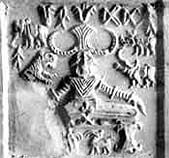 The proto-Siva seal found in Harappa (shown on the left) was treated as one of the proofs that Hinduism had its roots in Indus Valley. Analysis of the seal has led to various contradictory theories about the origins of religion, but a 1987 paper says that the posture of the depicted character has been overlooked and new analysis reveals something interesting.
The proto-Siva seal found in Harappa (shown on the left) was treated as one of the proofs that Hinduism had its roots in Indus Valley. Analysis of the seal has led to various contradictory theories about the origins of religion, but a 1987 paper says that the posture of the depicted character has been overlooked and new analysis reveals something interesting.
The body of the figure shown in the seal is naked, except for many bangles and what appear to be necklaces. He wears a peculiar headdress consisting of horns and a plant like object between them. This pattern was found in five seals and in one of them he is surrounded by an elephant, tiger, rhinoceros and a buffalo while beneath his stool are two deer’s which is also found in the representations of Buddha teaching his first sermon in the Deer Park in Varanasi.
The name proto-Siva was given by Sir John Marshall who led excavations that led to the discovery of Mohenjo-daro and Harappa in 1920s. Marshall thought that the protuberances on the sides were the second and third faces and Siva is often depicted with three faces and is also known as Pasupati (The Lord of Beasts). From this Marshall concluded that Saivism has a history of five thousand years making it the longest living faith in the world.
While Marshall identified the image as Siva, others have suggested that it is Agni. This was countered by others who thought that the the horns on the head-dress are suggestive of the trident and fertility aspect of Siva. Other interpretations include
- figure depicted on the seal is neither three faced, nor human but is a combination of various animals
- since the Indus religion was centered around the Mother Goddess cult, the figure on the seal is female.
- the figure is not Siva, but divine bull-man
While the head-dress, animals and other symbols depicted on the seal have been interpreted in various ways, Yan Dhyansky of University of California, Berkeley, suggests that the posture, which Marshall and few others called “yogic posture” has never been carefully examined. In his paper, The Indus Valley Origin of Yoga Practice, he suggests that Yoga was known and practiced by the people of Indus Valley civilization.
The person on the seal is seated with his legs drawn close to the body with two heels touching, which A L Basham calls, “a posture quite impossible for the average westerner”. This posture, has been identified by Yan as Mulabandhasana, which is difficult even for people who practice Yoga. (See this video and try it). The same posture has been depicted on all five proto-Siva seals found disproving the theory that it was the work of an imaginative artist. Besides this other seals have been found with figures in other yoga postures suggesting that people in the Indus valley were the practitioners of Yoga.
I read about proto-Siva from a book called Health, Healing and Beyond by TKV Desikachar. The book also talks about Yan Dhyansky who is a student of TKV Desikachar and how he figured out that the proto-Siva was in a complex yogic pose. Interesting Post.